Decomposition Analysis of Factors Affecting Changes in Industrial Wastewater Emission Intensity in China: Based on a SSBM-GMI Approach
Abstract
1. Introduction
2. Literature Review
3. Methodology
3.1. The Initial Decompsition Framework
3.2. The Improved Decompsition Framework
3.3. The Estimation Model
4. Data and Empirical Results
4.1. Data
4.2. Regional Difference in IWEI Change
4.3. Decomposition Results of Factors Affecting IWEI Change
4.3.1. Results at the Regional Level
4.3.2. Results at the National Level
5. Discussion
5.1. Regional Difference in Factors Driving IWEI Change
5.2. Envionmental Risk in Certain Areas
6. Conclusions and Policy Implications
6.1. Conclusions
6.2. Policy Implications
Author Contributions
Funding
Acknowledgments
Conflicts of Interest
Appendix A
Appendix B
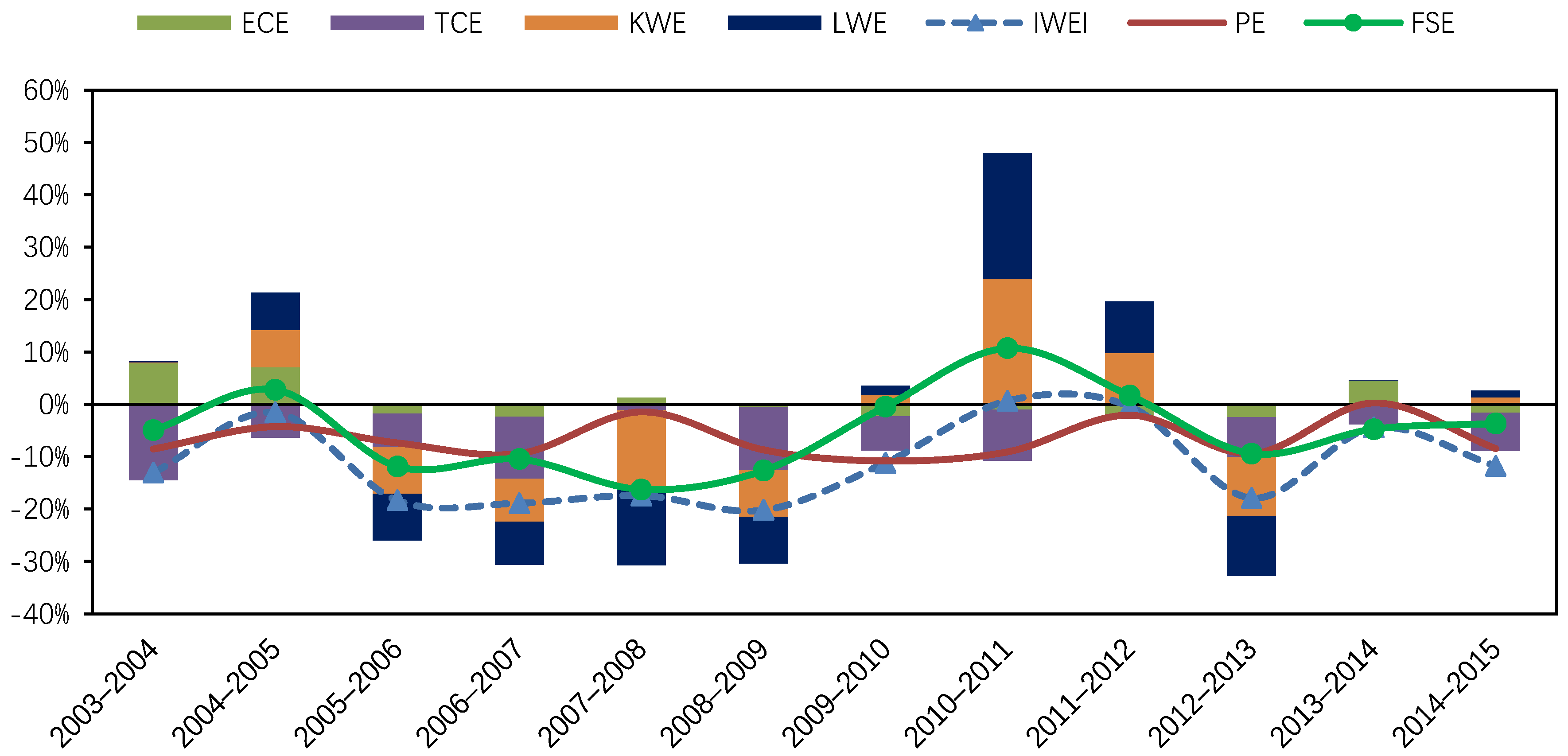

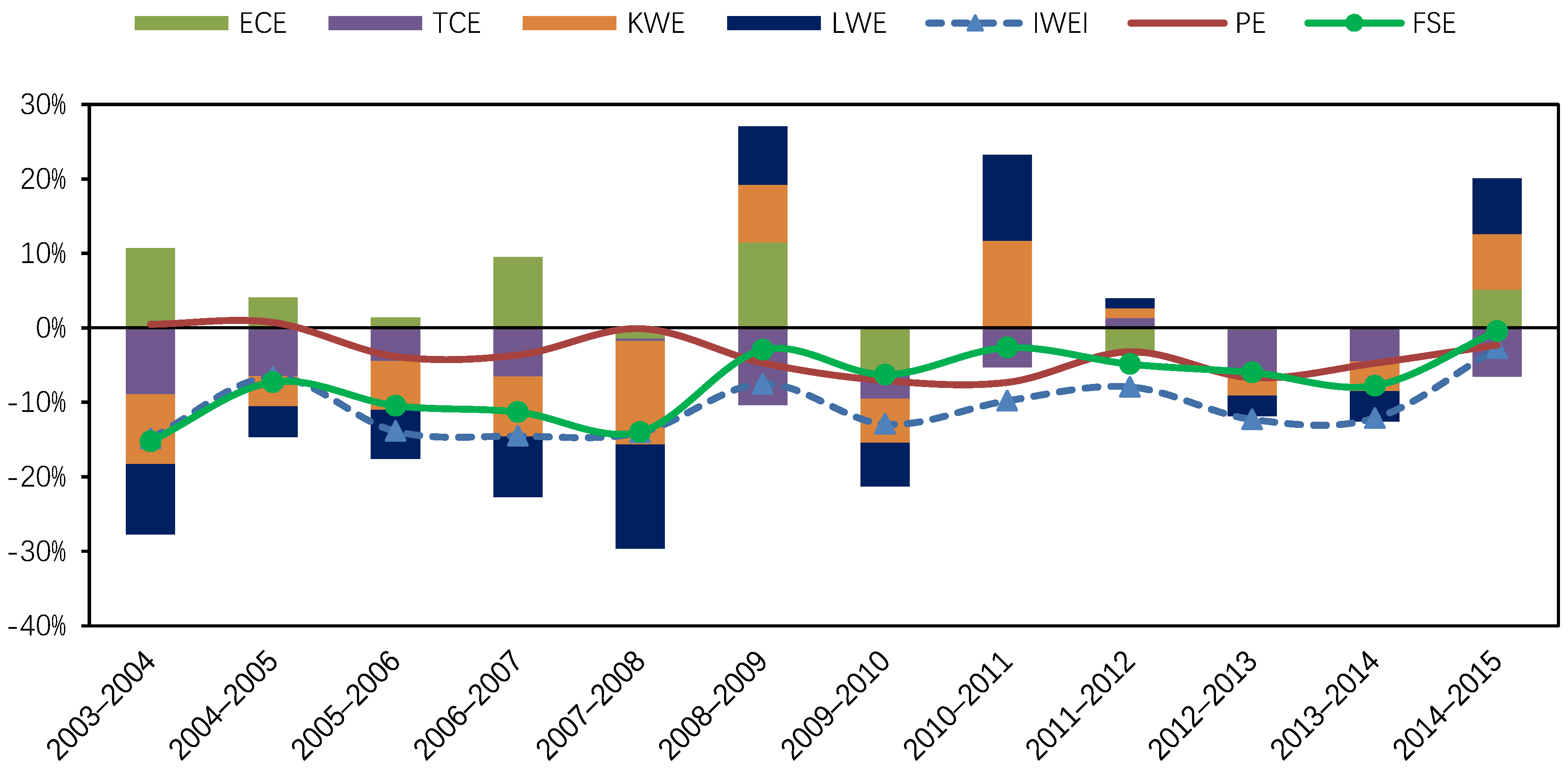

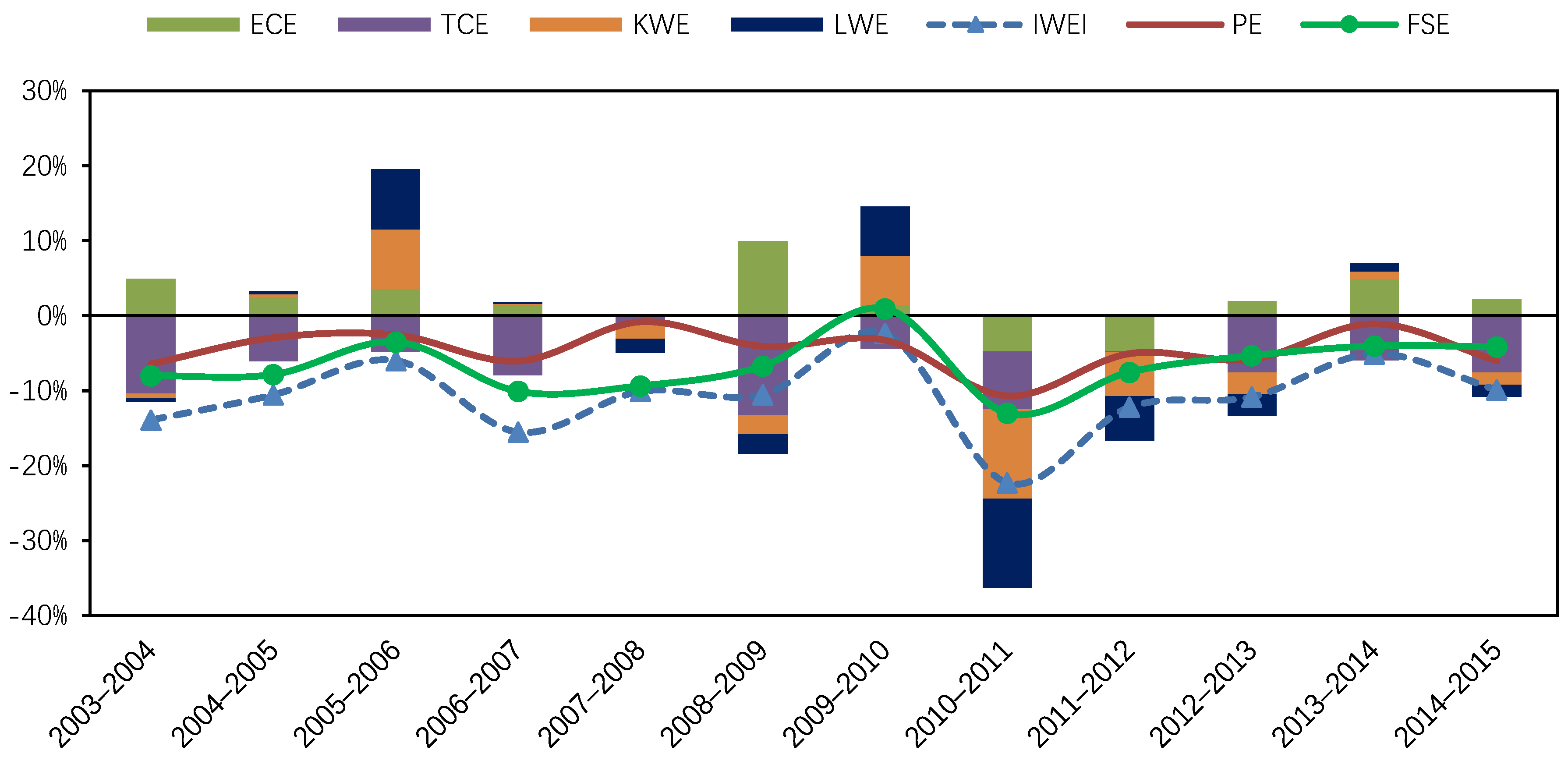
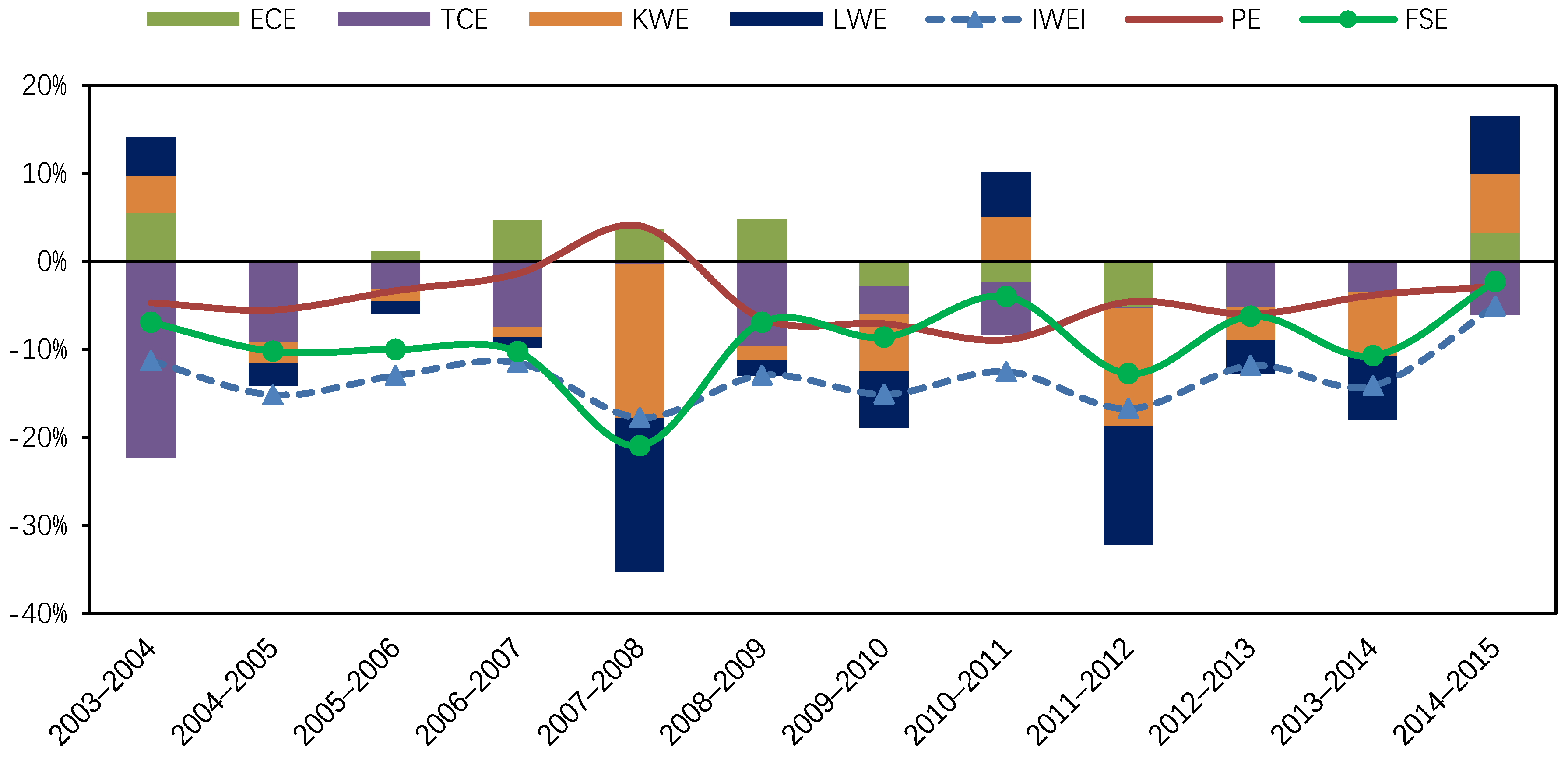
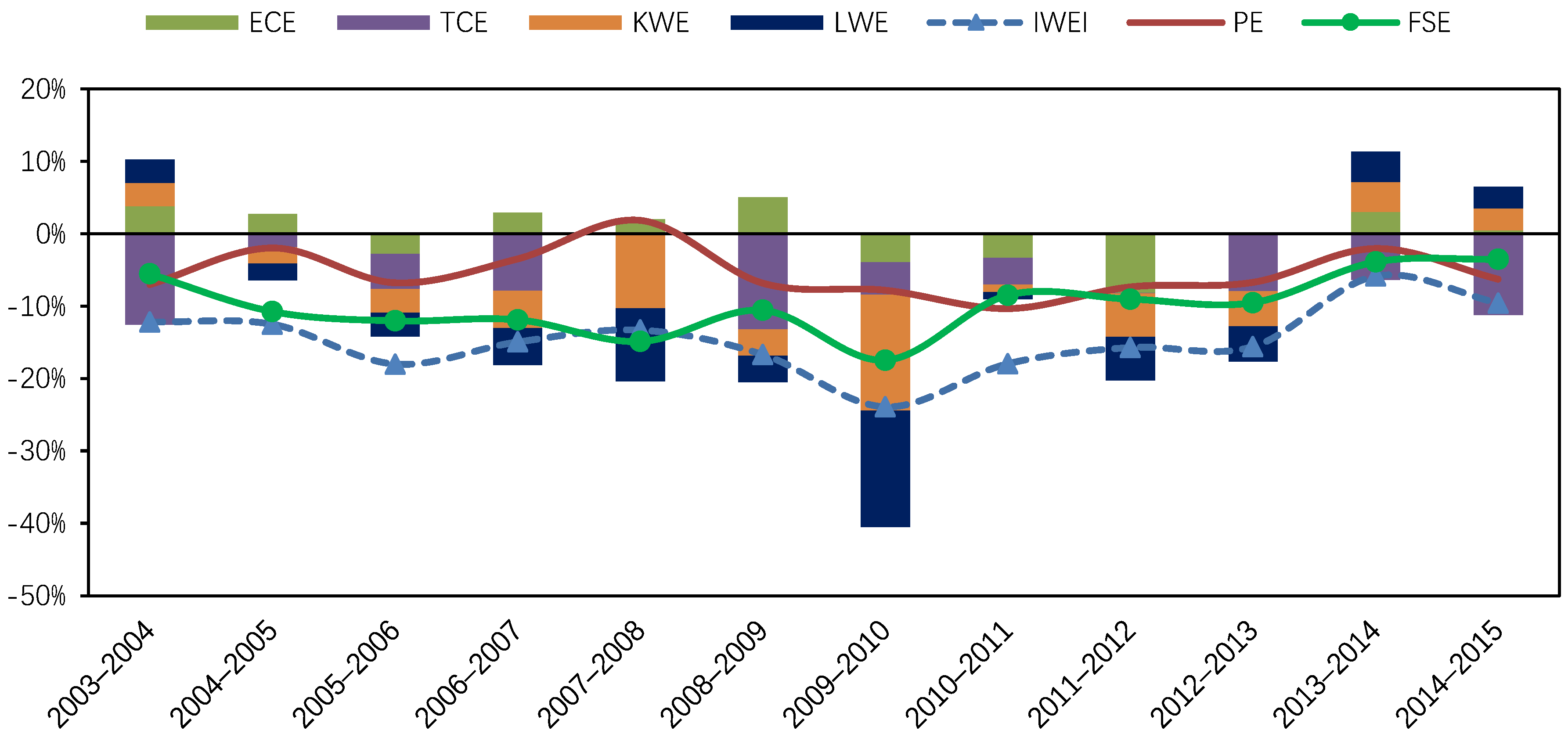
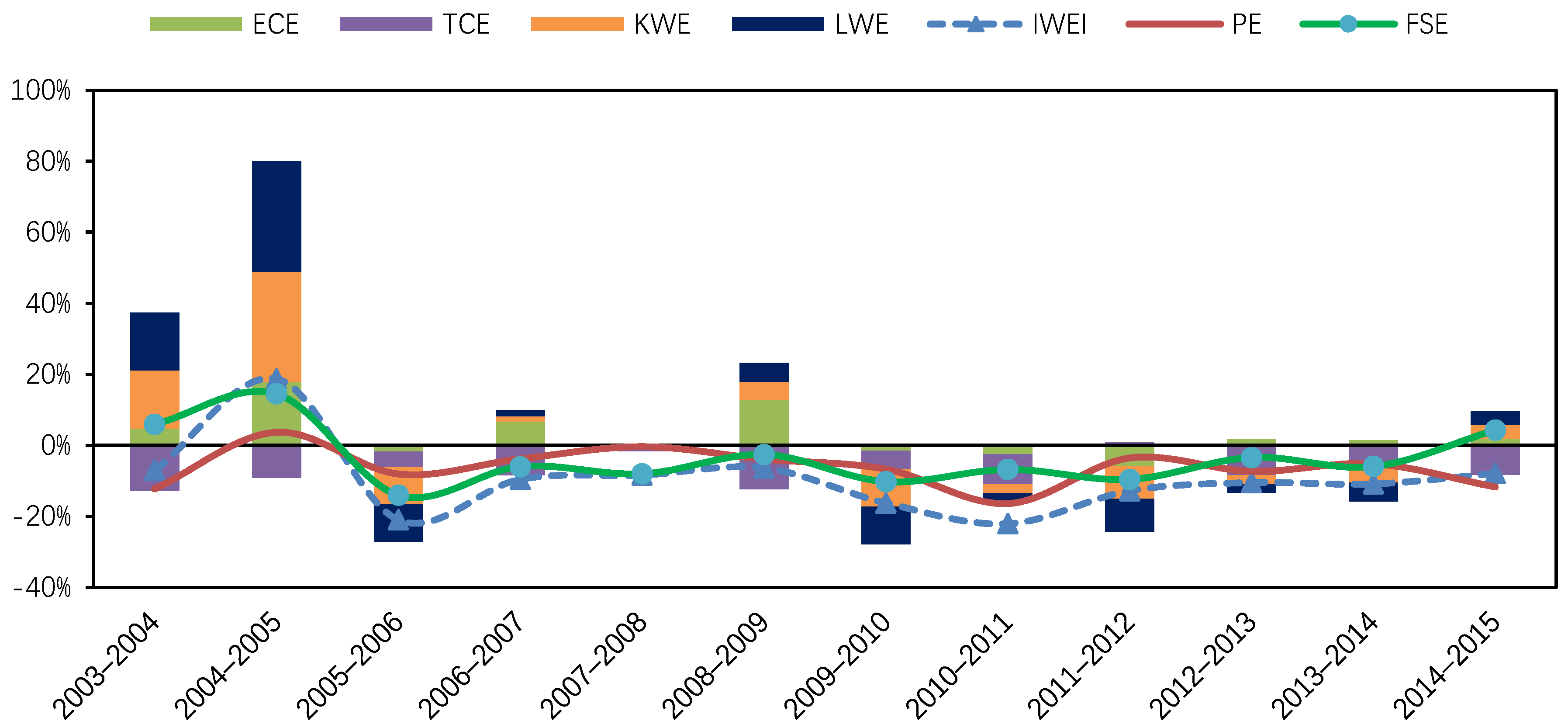
References
- Yale Center for Environmental Law & Policy, Yale University; Center for International Earth Science Information Network, Columbia University. 2018 Environmental Performance Index. Available online: https://epi.envirocenter.yale.edu/downloads/epi2018policymakerssummaryv01.pdf (accessed on 7 May 2018).
- Ebenstein, A. The consequences of industrialization: Evidence from water pollution and digestive cancers in china. Rev. Econ. Stat. 2012, 94, 186–201. [Google Scholar] [CrossRef]
- Zhang, J. The impact of water quality on health: Evidence from the drinking water infrastructure program in rural china. J. Health Econ. 2012, 31, 122–134. [Google Scholar] [CrossRef] [PubMed]
- The Ministry of Water Resources of the People’s Republic of China. China Water Resources Bulletin 2016. Available online: http://www.mwr.gov.cn/sj/tjgb/szygb/201707/t20170711_955305.html (accessed on 2 May 2018).
- Zhang, L.; Adom, P.K.; An, Y. Regulation-induced structural break and the long-run drivers of industrial pollution intensity in china. J. Clean. Prod. 2018, 198, 121–132. [Google Scholar] [CrossRef]
- Shao, W. Effectiveness of water protection policy in china: A case study of Jiaxing. Sci. Total Environ. 2010, 408, 690–701. [Google Scholar] [CrossRef] [PubMed]
- The State Council of the People’s Republic of China. The Action Plan for Prevention and Control of Water Pollution. Available online: http://www.gov.cn/zhengce/content/2015--04/16/content_9613.htm (accessed on 15 May 2018).
- U.S. Environmental Protection Agency. National Pollutant Discharge Elimination System (NPDES) Permit Writers’ Manual; U.S. Environmental Protection Agency: Washington, DC, USA, 2010.
- U.S. Environmental Protection Agency. Exposure Factors Handbook: 2011 Edition; U.S. Environmental Protection Agency: Washington, DC, USA, 2011.
- Alsheyab, M.; Kusch-Brandt, S. Potential recovery assessment of the embodied resources in qatar’s wastewater. Sustainability 2018, 10, 3055. [Google Scholar] [CrossRef]
- Lei, H.; Xia, X.; Li, C.; Xi, B. Decomposition analysis of wastewater pollutant discharges in industrial sectors of china (2001–2009) using the lmdi i method. Int. J. Environ. Res. Public Health 2012, 9, 2226–2240. [Google Scholar] [CrossRef] [PubMed]
- Fujii, H.; Managi, S.; Kaneko, S. Wastewater pollution abatement in china: A comparative study of fifteen industrial sectors from 1998 to 2010. J. Environ. Prot. 2013, 4, 290–300. [Google Scholar] [CrossRef]
- Geng, Y.; Wang, M.; Sarkis, J.; Xue, B.; Zhang, L.; Fujita, T.; Yu, X.; Ren, W.; Zhang, L.; Dong, H. Spatial-temporal patterns and driving factors for industrial wastewater emission in china. J. Clean. Prod. 2014, 76, 116–124. [Google Scholar] [CrossRef]
- Chen, K.; Liu, X.; Ding, L.; Huang, G.; Li, Z. Spatial characteristics and driving factors of provincial wastewater discharge in china. Int. J. Environ. Res. Public Health 2016, 13, 1221. [Google Scholar] [CrossRef] [PubMed]
- Jia, J.; Jian, H.; Xie, D.; Gu, Z.; Chen, C. Multi-perspectives’ comparisons and mitigating implications for the cod and nh3-n discharges into the wastewater from the industrial sector of china. Water 2017, 9, 201. [Google Scholar] [CrossRef]
- The Ministry of Environmental Protection of the People’s Republic of China. Annual Statistic Report on Environment in China; China Environmental Science Press: Beijing, China, 2006–2016. [Google Scholar]
- Grossman, G.M.; Krueger, A.B. Environmental Impacts of a North American Free Trade Agreement; National Bureau of Economic Research: Cambridge, MA, USA, 1991. [Google Scholar]
- Panayotou, T. Empirical Tests and Policy Analysis of Environmental Degradation at Different Stages of Economic Development; International Labour Organization: Geneva, Switzerland, 1993. [Google Scholar]
- Grossman, G.M.; Krueger, A.B. Economic growth and the environment. Q. J. Econ. 1995, 110, 353–377. [Google Scholar] [CrossRef]
- Hamilton, C.; Turton, H. Determinants of emissions growth in OECD countries. Energy Policy 2002, 30, 63–71. [Google Scholar] [CrossRef]
- Stern, D.I. Explaining changes in global sulfur emissions: An econometric decomposition approach. Ecol. Econ. 2002, 42, 201–220. [Google Scholar] [CrossRef]
- Bruvoll, A.; Medin, H. Factors behind the environmental kuznets curve. A decomposition of the changes in air pollution. Environ. Resour. Econ. 2003, 24, 27–48. [Google Scholar] [CrossRef]
- Su, W.; Zhang, C. The inspection of EKC hypothesis in China based on heterogeneity. Stat. Res. 2011, 12, 011. [Google Scholar]
- Fan, S.; Gao, T. Change status of industrial pollution of china and its ekc empirical analysis based on ecological threshold perspective. Ecol. Econ. 2017, 9, 023. [Google Scholar]
- Guo, W.-W. EKC Analysis of Three Industrial Wastes of Five Provinces in Northwest China; IOP Conference Series: Earth and Environmental Science; IOP Publishing: Bristol, UK, 2018; p. 062075. [Google Scholar]
- Ang, B.W. The LMDI approach to decomposition analysis: A practical guide. Energy Policy 2005, 33, 867–871. [Google Scholar] [CrossRef]
- Shao, C.; Guan, Y.; Wan, Z.; Guo, C.; Chu, C.; Ju, M. Performance and decomposition analyses of carbon emissions from industrial energy consumption in Tianjin, China. J. Clean. Prod. 2014, 64, 590–601. [Google Scholar] [CrossRef]
- Li, Y.; Luo, Y.; Wang, Y.; Wang, L.; Shen, M. Decomposing the decoupling of water consumption and economic growth in china’s textile industry. Sustainability 2017, 9, 412. [Google Scholar] [CrossRef]
- Lin, B.; Du, K. Decomposing energy intensity change: A combination of index decomposition analysis and production-theoretical decomposition analysis. Appl. Energy 2014, 129, 158–165. [Google Scholar] [CrossRef]
- Du, K.; Lin, B. Understanding the rapid growth of china’s energy consumption: A comprehensive decomposition framework. Energy 2015, 90, 570–577. [Google Scholar] [CrossRef]
- Li, A.J.; Zhang, A.Z.; Zhou, Y.X.; Yao, X. Decomposition analysis of factors affecting carbon dioxide emissions across provinces in china. J. Clean. Prod. 2017, 141, 1428–1444. [Google Scholar] [CrossRef]
- Wang, Q.; Zhang, C.; Cai, W. Factor substitution and energy productivity fluctuation in china: A parametric decomposition analysis. Energy Policy 2017, 109, 181–190. [Google Scholar] [CrossRef]
- Chen, X.; Fan, D. Empirical Study on Status of Industrial Water Pollution and Treatment Efficiency in China. Stat. Inf. Forum 2009, 3, 30–35. [Google Scholar]
- Sala-Garrido, R.; Molinos-Senante, M.; Hernández-Sancho, F. Comparing the efficiency of wastewater treatment technologies through a dea metafrontier model. Chem. Eng. J. 2011, 173, 766–772. [Google Scholar] [CrossRef]
- Liu, Y.; Gong, B.; Liu, X. An appraise of wastewater treatment efficiency in china mineral industries based on dea models with undesirable outputs. Chin. J. Environ. Eng. 2017, 11, 2073–2078. [Google Scholar]
- Yang, W.; Li, L. Efficiency evaluation and policy analysis of industrial wastewater control in China. Energies 2017, 10, 1201. [Google Scholar] [CrossRef]
- Fujii, H.; Managi, S. Wastewater management efficiency and determinant factors in the Chinese industrial sector from 2004 to 2014. Water 2017, 9, 586. [Google Scholar] [CrossRef]
- Li, H.; Zhang, J.; Osei, E.; Yu, M. Sustainable development of china’s industrial economy: An empirical study of the period 2001–2011. Sustainability 2018, 10, 764. [Google Scholar] [CrossRef]
- Fujii, H.; Cao, J.; Managi, S. Decomposition of productivity considering multi-environmental pollutants in Chinese industrial sector. Rev. Dev. Econ. 2015, 19, 75–84. [Google Scholar] [CrossRef]
- Chen, C.; Lan, Q.; Gao, M.; Sun, Y. Green total factor productivity growth and its determinants in China’s industrial economy. Sustainability 2018, 10, 1052. [Google Scholar] [CrossRef]
- Fare, R.; Grosskopf, S.; Pasurkajr, C. Environmental production functions and environmental directional distance functions. Energy 2007, 32, 1055–1066. [Google Scholar] [CrossRef]
- Zhou, P.; Ang, B.W. Decomposition of aggregate co2 emissions: A production-theoretical approach. Energy Econ. 2008, 30, 1054–1067. [Google Scholar] [CrossRef]
- Zhang, N.; Zhou, P.; Choi, Y. Energy efficiency, co2 emission performance and technology gaps in fossil fuel electricity generation in Korea: A meta-frontier non-radial directional distance function analysis. Energy Policy 2013, 56, 653–662. [Google Scholar] [CrossRef]
- Timmer, M.P.; Los, B. Localized innovation and productivity growth in asia: An intertemporal dea approach. J. Prod. Anal. 2005, 23, 47–64. [Google Scholar] [CrossRef]
- Tone, K. A slacks-based measure of efficiency in data envelopment analysis. Eur. J. Oper. Res. 2001, 130, 498–509. [Google Scholar] [CrossRef]
- Tone, K. A slacks-based measure of super-efficiency in data envelopment analysis. Eur. J. Oper. Res. 2002, 143, 32–41. [Google Scholar] [CrossRef]
- Pastor, J.T.; Lovell, C.A.K. A global malmquist productivity index. Econ. Lett. 2005, 88, 266–271. [Google Scholar] [CrossRef]
- Oh, D.-H. A global malmquist-luenberger productivity index. J. Prod. Anal. 2010, 34, 183–197. [Google Scholar] [CrossRef]
- Oh, D.-H.; Heshmati, A. A sequential malmquist–luenberger productivity index: Environmentally sensitive productivity growth considering the progressive nature of technology. Energy Econ. 2010, 32, 1345–1355. [Google Scholar] [CrossRef]
- Wang, C. Decomposing energy productivity change: A distance function approach. Energy 2007, 32, 1326–1333. [Google Scholar] [CrossRef]
- Wang, C. Sources of energy productivity growth and its distribution dynamics in china. Resour. Energy Econ. 2011, 33, 279–292. [Google Scholar] [CrossRef]
- Ang, B.W. Decomposition analysis for policymaking in energy: Which is the preferred method? Energy Policy 2004, 32, 1131–1139. [Google Scholar] [CrossRef]
- Boyd, G.A.; Pang, J.X. Estimating the linkage between energy efficiency and productivity. Energy Policy 2000, 28, 289–296. [Google Scholar] [CrossRef]
- Smyth, R.; Narayan, P.K.; Shi, H. Substitution between energy and classical factor inputs in the chinese steel sector. Appl. Energy 2011, 88, 361–367. [Google Scholar] [CrossRef]
- National Bureau of Statistics of the People’s Republic of China. China Statistical Yearbook; China Statistics Press: Beijing, China, 2004–2016. [Google Scholar]
- Ministry of Environmental Protection of the People’s Republic of China. China’s Environmental Yearbook; China Environmental Science Press: Beijing, China, 2004–2006. [Google Scholar]
- Hall, R.E.; Jones, C.I. Why do some countries produce so much more output per worker than others? Q. J. Econ. 1999, 114, 83–116. [Google Scholar] [CrossRef]
- Zheng, X.; Zhang, Z.; Yu, D.; Chen, X.; Cheng, R.; Min, S.; Wang, J.; Xiao, Q.; Wang, J. Overview of membrane technology applications for industrial wastewater treatment in China to increase water supply. Resour. Conserv. Recycl. 2015, 105, 1–10. [Google Scholar] [CrossRef]
- Wu, H.; Guo, H.; Zhang, B.; Bu, M. Westward movement of new polluting firms in China: Pollution reduction mandates and location choice. J. Comp. Econ. 2017, 45, 119–138. [Google Scholar] [CrossRef]
- Dean, J.M.; Lovely, M.E.; Wang, H. Are Foreign Investors Attracted to Weak Environmental Regulations? Evaluating the Evidence from China; The World Bank: Washington, DC, USA, 2005. [Google Scholar]
- Copeland, B.R.; Taylor, M.S. Trade, spatial separation, and the environment. J. Int. Econ. 1999, 47, 137–168. [Google Scholar] [CrossRef]
- Antweiler, W.; Copeland, R.; Taylor, M.S. Is free trade good for the emissions: 1950–2050. Rev. Econ. Stat. 2001, 80, 15–27. [Google Scholar]
- Copeland, B.R.; Taylor, M.S. Trade, Tragedy, and the Commons; National Bureau of Economic Research: Cambridge, MA, USA, 2004. [Google Scholar]
- Kahn, M. Domestic pollution havens: Evidence from cancer deaths in border counties. J. Urban Econ. 2004, 56, 51–69. [Google Scholar] [CrossRef]
- Kellenberg, D.K. An empirical investigation of the pollution haven effect with strategic environment and trade policy. J. Int. Econ. 2009, 78, 242–255. [Google Scholar] [CrossRef]
- Wagner, U.J.; Timmins, C.D. Agglomeration effects in foreign direct investment and the pollution haven hypothesis. Environ. Resour. Econ. 2009, 43, 231–256. [Google Scholar] [CrossRef]
- Chung, S. Environmental regulation and foreign direct investment: Evidence from south Korea. J. Dev. Econ. 2014, 108, 222–236. [Google Scholar] [CrossRef]
- Stokey, N.L. Are there limits to growth? Int. Econ. Rev. 1998, 39, 1–31. [Google Scholar] [CrossRef]
- Chow, G.C. China’s Environmental Policy: A Critical Survey; Princeton University Center for Economic Policy Studies: Princeton, NJ, USA, 2010. [Google Scholar]
- Zhang, D.; Aunan, K.; Seip, H.M.; Vennemo, H. The energy intensity target in China’s 11th five-year plan period—Local implementation and achievements in Shanxi province. Energy Policy 2011, 39, 4115–4124. [Google Scholar] [CrossRef]
- Cai, H.; Chen, Y.; Gong, Q. Polluting thy neighbor: Unintended consequences of China’s pollution reduction mandates. J. Environ. Econ. Manag. 2016, 76, 86–104. [Google Scholar] [CrossRef]
- Shen, M.; Yang, Y. The water pollution policy regime shift and boundary pollution: Evidence from the change of water pollution levels in China. Sustainability 2017, 9, 1469. [Google Scholar] [CrossRef]
- Hailu, A.; Veeman, T.S. Non-parametric productivity analysis with undesirable outputs: An application to the canadian pulp and paper industry. Am. J. Agric. Econ. 2001, 83, 605–616. [Google Scholar] [CrossRef]
- Korhonen, P.J.; Luptacik, M. Eco-efficiency analysis of power plants: An extension of data envelopment analysis. Eur. J. Oper. Res. 2004, 154, 437–446. [Google Scholar] [CrossRef]
- Kumar, S. Environmentally sensitive productivity growth: A global analysis using malmquist–luenberger index. Ecol. Econ. 2006, 56, 280–293. [Google Scholar] [CrossRef]
- Färe, R.; Grosskopf, S.; Pasurka, J.; Carl, A. Accounting for air pollution emissions in measures of state manufacturing productivity growth. J. Reg. Sci. 2001, 41, 381–409. [Google Scholar]
- Hailu, A.; Veeman, T.S. Environmentally sensitive productivity analysis of the canadian pulp and paper industry, 1959–1994: An input distance function approach. J. Environ. Econ. Manag. 2000, 40, 251–274. [Google Scholar] [CrossRef]
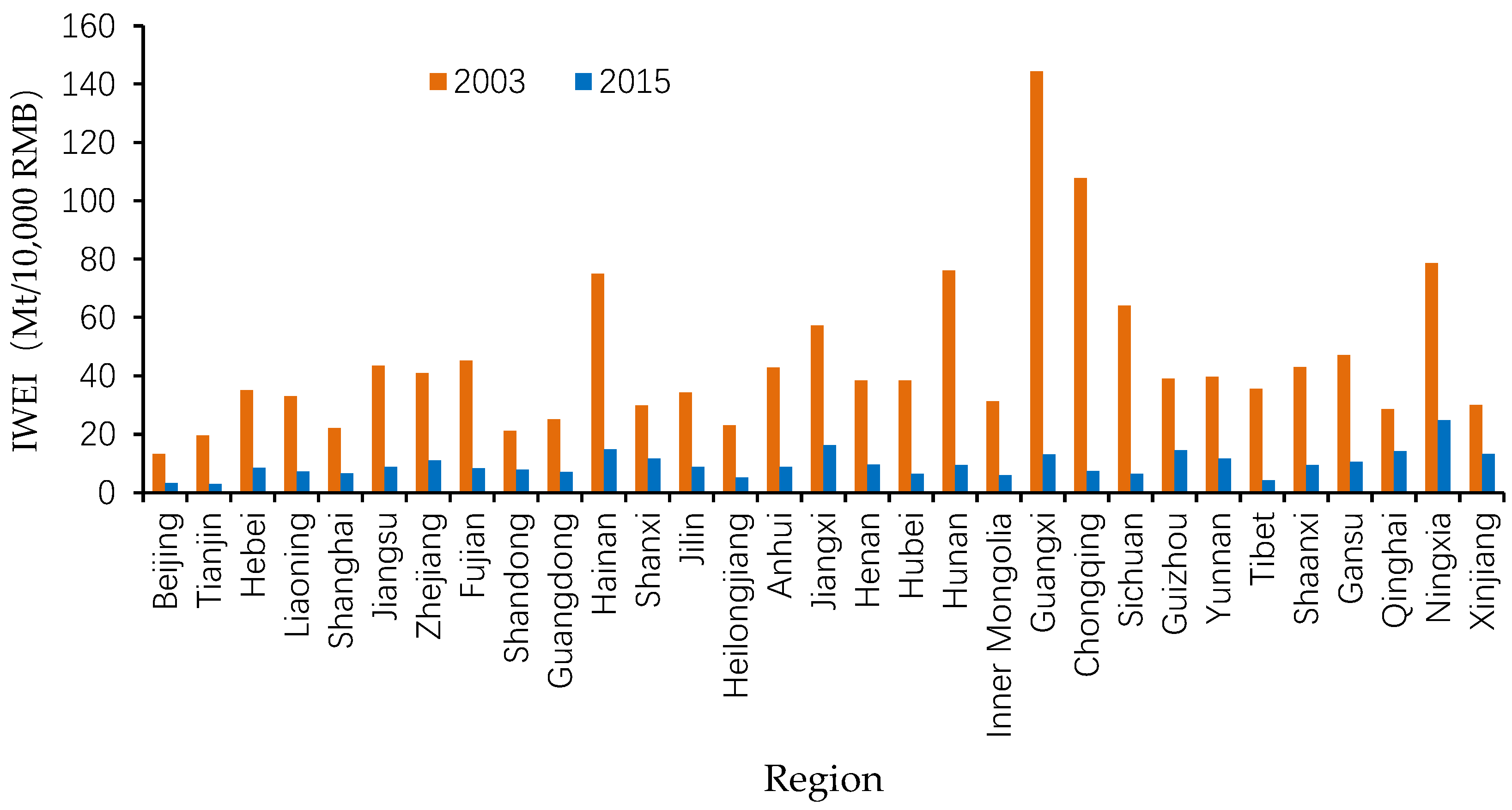
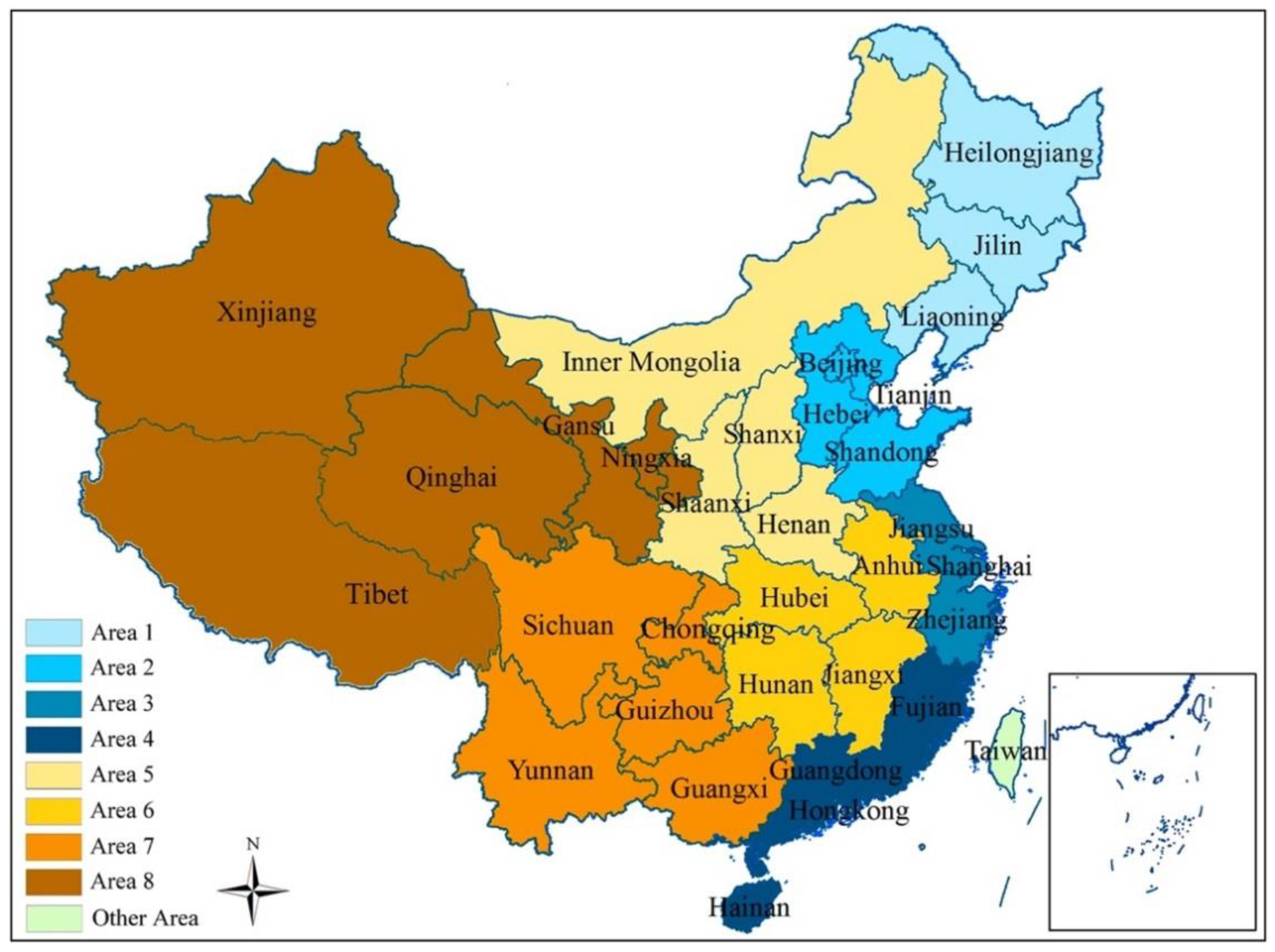
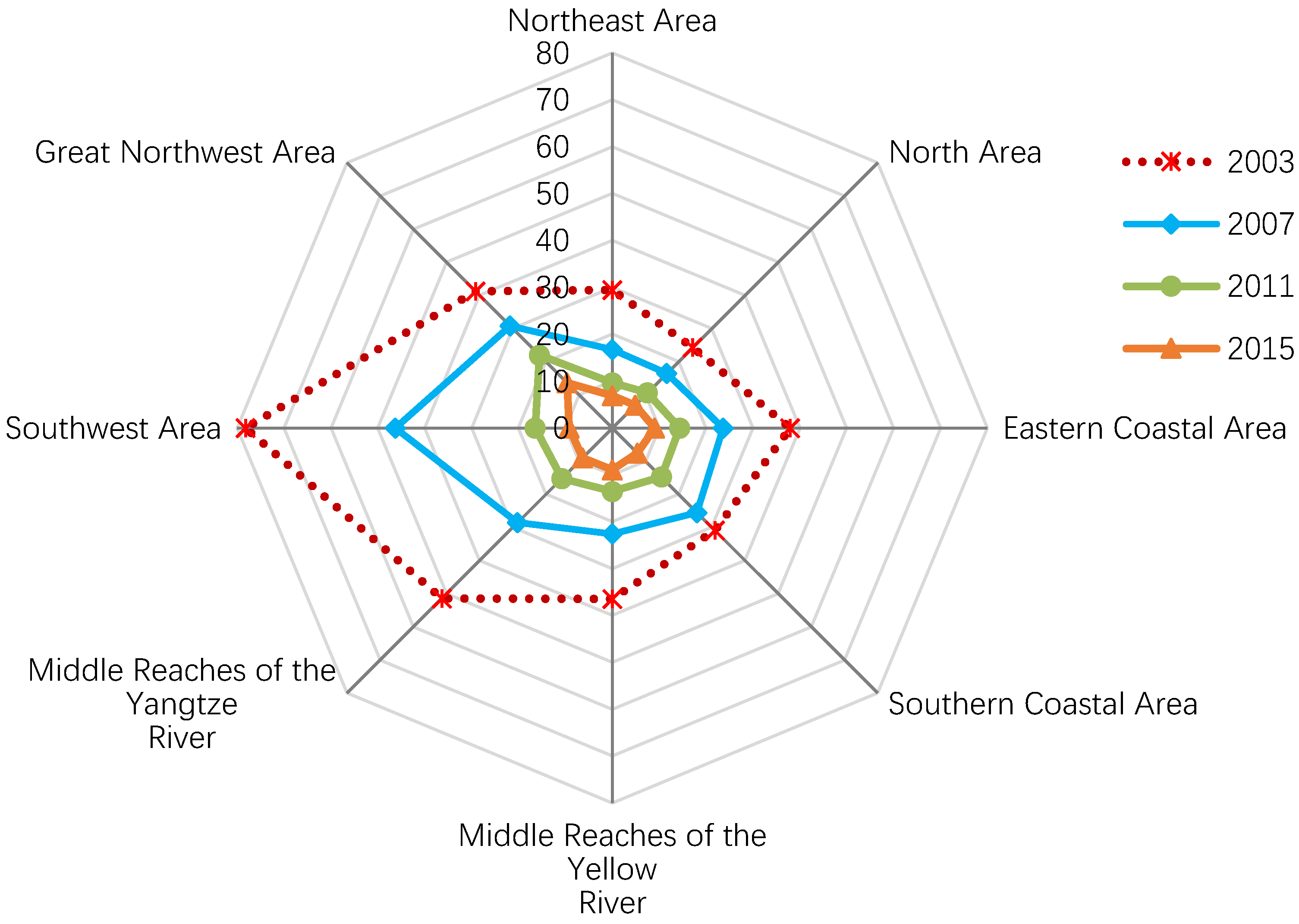
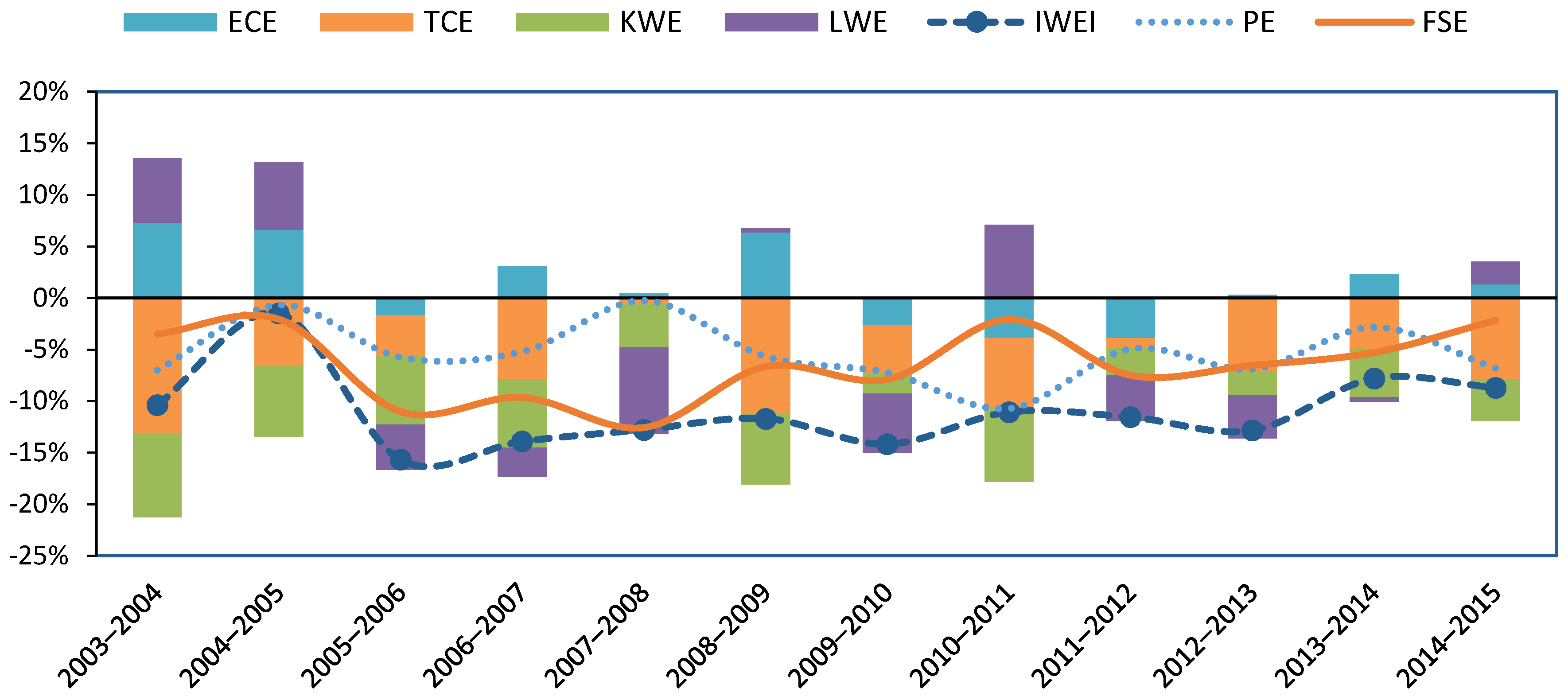
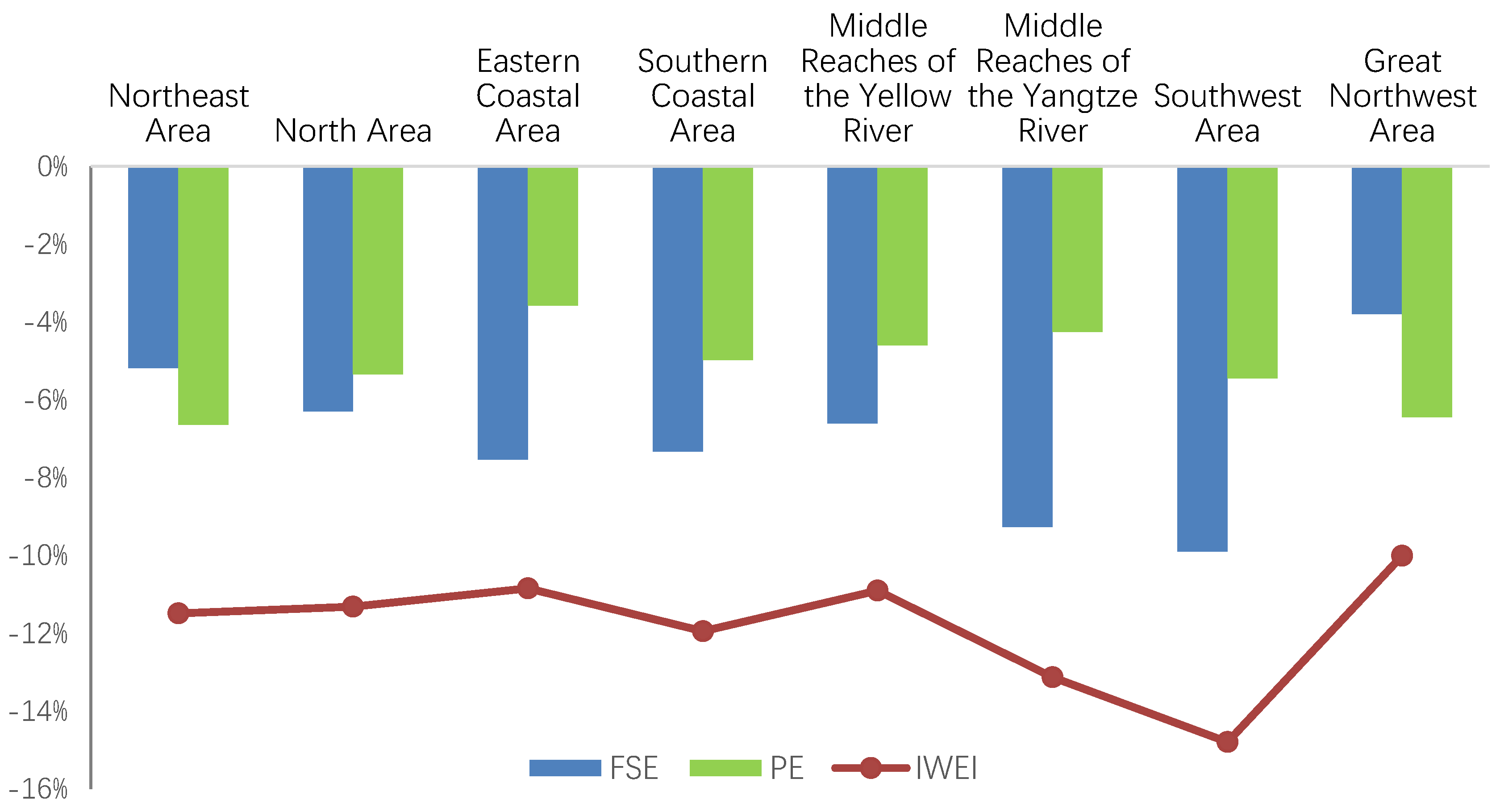
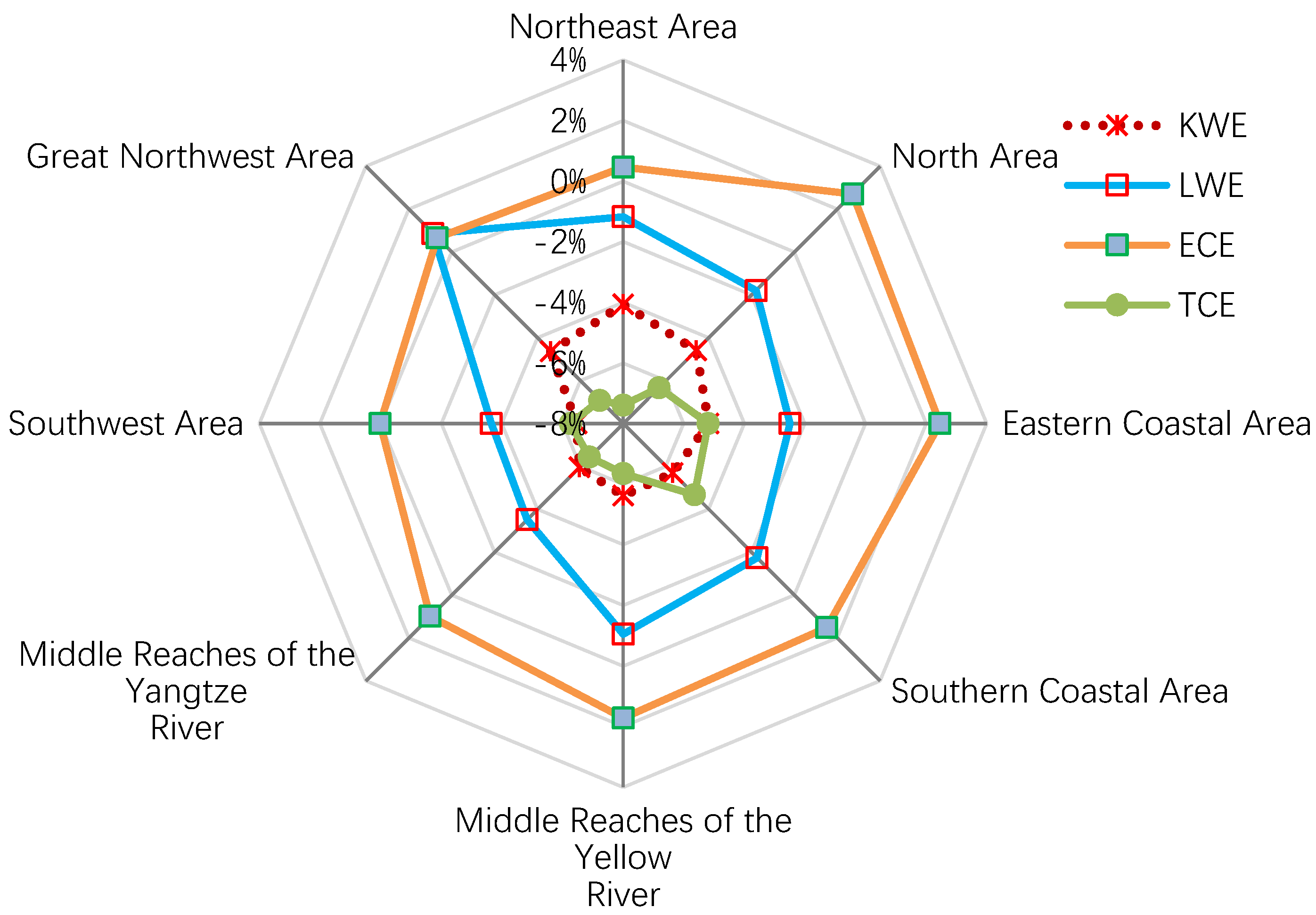
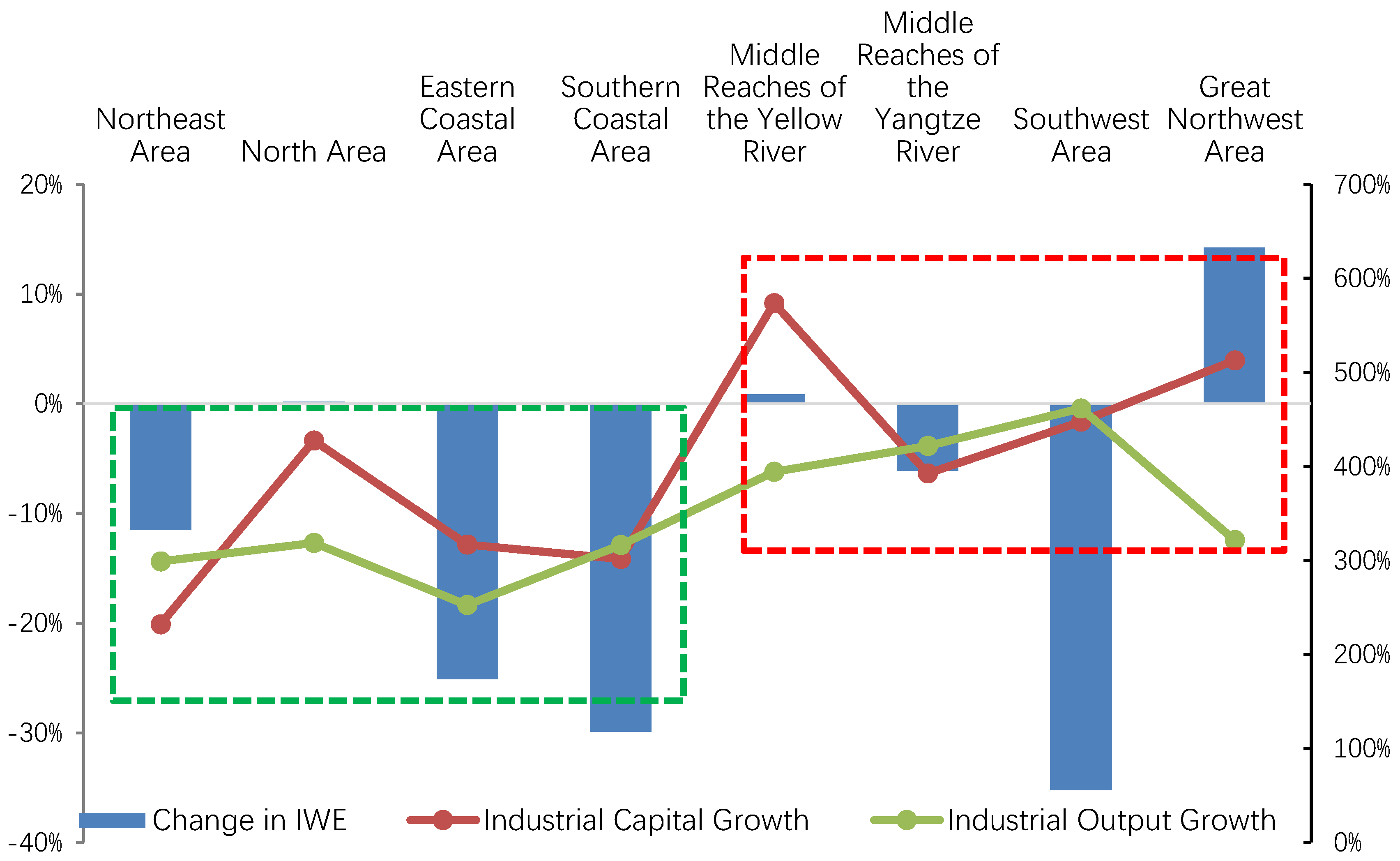
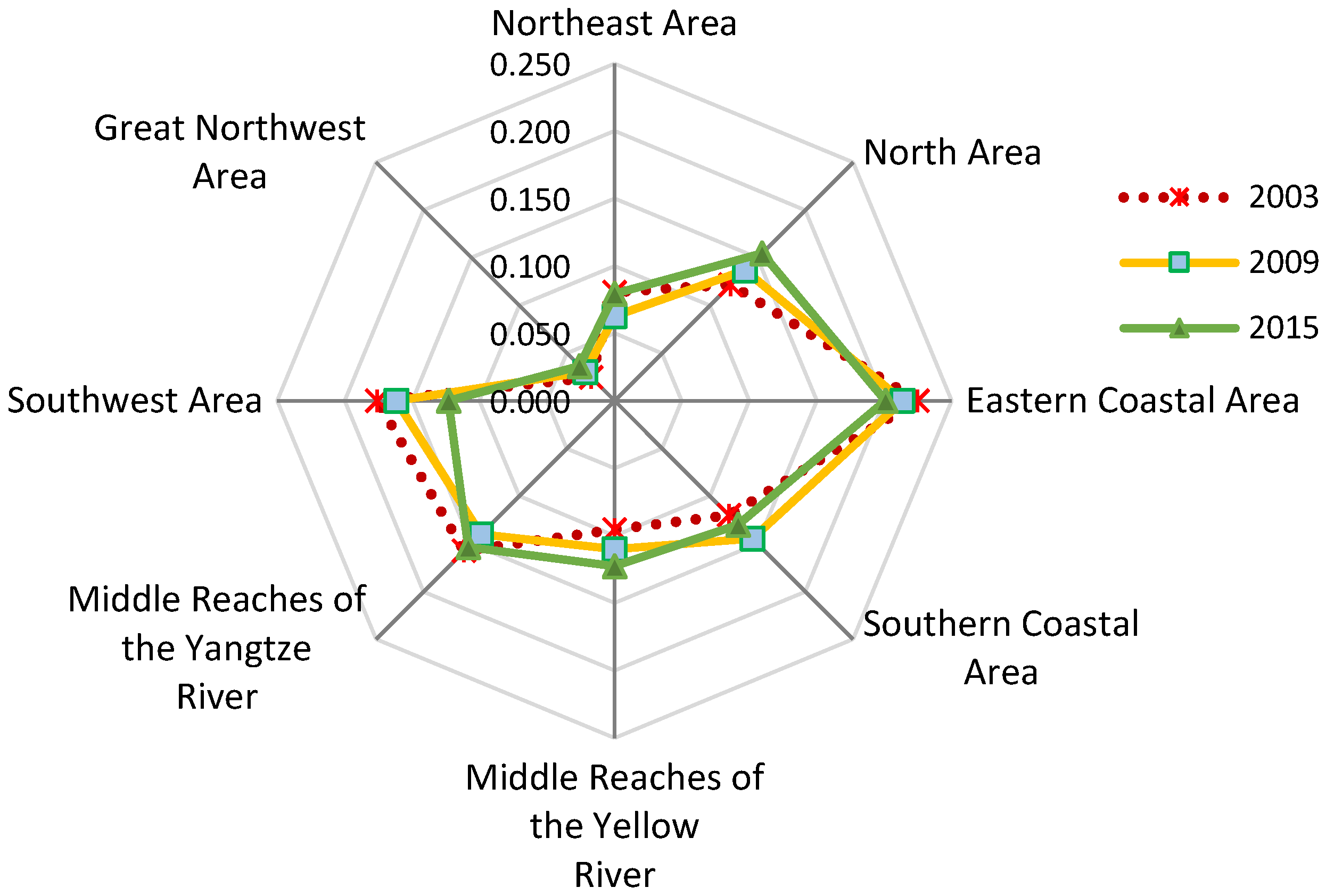
| Variable | Units | Mean | Stander. Deviation. | Max | Min | Opservations |
|---|---|---|---|---|---|---|
| K | 100 million RMB | 8023.56 | 7556.17 | 45,276.12 | 57.74 | 403 |
| L | 10 Thousand People | 271.61 | 306.62 | 1568.00 | 1.63 | 403 |
| W | 10 Thousand Mt | 73,052.02 | 63,715.72 | 296,318.00 | 363.00 | 403 |
| Y | 100 million RMB | 4479.25 | 4630.30 | 24,092.77 | 17.24 | 403 |
| Province | 2003 | 2015 | Variation (%) | Province | 2003 | 2015 | Variation (%) |
|---|---|---|---|---|---|---|---|
| Beijing | 13.23 | 3.22 | −75.68 | Hubei | 38.42 | 6.34 | −83.50 |
| Tianjin | 19.51 | 2.87 | −85.29 | Hunan | 76.05 | 9.32 | −87.75 |
| Hebei | 35.12 | 8.40 | −76.07 | Guangdong | 25.02 | 7.08 | −71.69 |
| Shanxi | 29.89 | 11.56 | −61.32 | Guangxi | 144.29 | 12.99 | −91.00 |
| Inner Mongolia | 31.23 | 5.84 | −81.30 | Hainan | 74.93 | 14.83 | −80.21 |
| Liaoning | 33.03 | 7.15 | −78.34 | Chongqing | 107.70 | 7.38 | −93.15 |
| Jilin | 34.27 | 8.73 | −74.51 | Sichuan | 64.10 | 6.45 | −89.94 |
| Heilongjiang | 22.96 | 5.14 | −77.64 | Guizhou | 39.00 | 14.43 | −62.99 |
| Shanghai | 22.14 | 6.61 | −70.15 | Yunnan | 39.60 | 11.57 | −70.77 |
| Jiangsu | 43.49 | 8.67 | −80.06 | Tibet | 35.49 | 4.18 | −88.23 |
| Zhejiang | 40.89 | 11.01 | −73.07 | Shaanxi | 42.94 | 9.40 | −78.11 |
| Anhui | 42.77 | 8.69 | −79.69 | Gansu | 47.15 | 10.43 | −77.88 |
| Fujian | 45.14 | 8.25 | −81.72 | Qinghai | 28.52 | 14.17 | −50.31 |
| Jiangxi | 57.15 | 16.13 | −71.77 | Ningxia | 78.61 | 24.74 | −68.52 |
| Shandong | 21.09 | 7.74 | −63.31 | Xinjiang | 30.02 | 13.20 | −56.05 |
| Henan | 38.40 | 9.48 | −75.31 | Mean | 45.23 | 9.55 | −75.98 |
| Area | Province | IWEI Change (1) | ECE (2) | TCE (3) | PE (4) | KWE (5) | LWE (6) | FSE (7) |
|---|---|---|---|---|---|---|---|---|
| Northeast Area | Liaoning | 0.880 | 0.995 | 0.936 | 0.931 | 0.958 | 0.986 | 0.945 |
| Jilin | 0.892 | 1.003 | 0.935 | 0.937 | 0.960 | 0.991 | 0.952 | |
| Heilongjiang | 0.883 | 1.016 | 0.917 | 0.932 | 0.960 | 0.987 | 0.947 | |
| Mean | 0.885 | 1.005 | 0.929 | 0.933 | 0.959 | 0.988 | 0.948 | |
| North Area | Beijing | 0.889 | 1.058 | 0.898 | 0.950 | 0.961 | 0.974 | 0.936 |
| Tianjin | 0.852 | 0.979 | 0.920 | 0.901 | 0.969 | 0.977 | 0.947 | |
| Hebei | 0.888 | 1.025 | 0.946 | 0.969 | 0.937 | 0.978 | 0.916 | |
| Shandong | 0.920 | 1.049 | 0.923 | 0.968 | 0.950 | 1.000 | 0.950 | |
| Mean | 0.887 | 1.027 | 0.922 | 0.947 | 0.954 | 0.982 | 0.937 | |
| Eastern Coastal Area | Shanghai | 0.904 | 1.024 | 0.926 | 0.949 | 0.969 | 0.983 | 0.953 |
| Jiangsu | 0.874 | 1.022 | 0.949 | 0.969 | 0.936 | 0.963 | 0.902 | |
| Zhejiang | 0.896 | 1.028 | 0.948 | 0.975 | 0.939 | 0.979 | 0.919 | |
| Mean | 0.891 | 1.025 | 0.941 | 0.964 | 0.948 | 0.975 | 0.924 | |
| Southern Coastal Area | Fujian | 0.868 | 1.033 | 0.926 | 0.956 | 0.935 | 0.971 | 0.907 |
| Guangdong | 0.900 | 1.021 | 0.940 | 0.960 | 0.959 | 0.978 | 0.937 | |
| Hainan | 0.874 | 0.991 | 0.942 | 0.934 | 0.936 | 0.999 | 0.936 | |
| Mean | 0.881 | 1.015 | 0.936 | 0.950 | 0.943 | 0.983 | 0.927 | |
| Middle Reaches of the Yellow River | Shanxi | 0.924 | 1.038 | 0.932 | 0.967 | 0.945 | 1.010 | 0.955 |
| Inner Mongolia | 0.870 | 0.991 | 0.934 | 0.926 | 0.946 | 0.993 | 0.940 | |
| Henan | 0.890 | 1.031 | 0.950 | 0.979 | 0.935 | 0.972 | 0.909 | |
| Shaanxi | 0.881 | 1.010 | 0.936 | 0.945 | 0.949 | 0.983 | 0.933 | |
| Mean | 0.891 | 1.017 | 0.938 | 0.954 | 0.944 | 0.989 | 0.934 | |
| Middle Reaches of the Yangtze River | Anhui | 0.876 | 1.015 | 0.947 | 0.962 | 0.939 | 0.969 | 0.910 |
| Jiangxi | 0.900 | 1.032 | 0.951 | 0.981 | 0.940 | 0.976 | 0.917 | |
| Hubei | 0.861 | 0.991 | 0.939 | 0.931 | 0.959 | 0.964 | 0.924 | |
| Hunan | 0.839 | 1.001 | 0.954 | 0.956 | 0.924 | 0.950 | 0.878 | |
| Mean | 0.869 | 1.010 | 0.948 | 0.957 | 0.940 | 0.965 | 0.907 | |
| Southwest Area | Guangxi | 0.818 | 0.991 | 0.955 | 0.946 | 0.921 | 0.939 | 0.865 |
| Chongqing | 0.800 | 0.985 | 0.954 | 0.940 | 0.916 | 0.930 | 0.851 | |
| Sichuan | 0.826 | 0.982 | 0.947 | 0.930 | 0.935 | 0.949 | 0.888 | |
| Guizhou | 0.921 | 1.027 | 0.935 | 0.961 | 0.953 | 1.005 | 0.958 | |
| Yunnan | 0.903 | 1.017 | 0.936 | 0.952 | 0.952 | 0.996 | 0.948 | |
| Mean | 0.852 | 1.000 | 0.945 | 0.946 | 0.935 | 0.963 | 0.901 | |
| Great Northwest Area | Tibet | 0.837 | 0.932 | 0.927 | 0.863 | 0.964 | 1.005 | 0.969 |
| Gansu | 0.882 | 0.996 | 0.936 | 0.932 | 0.941 | 1.005 | 0.946 | |
| Qinghai | 0.943 | 1.033 | 0.916 | 0.946 | 0.965 | 1.033 | 0.997 | |
| Ningxia | 0.908 | 1.028 | 0.941 | 0.967 | 0.935 | 1.003 | 0.939 | |
| Xinjiang | 0.934 | 1.050 | 0.926 | 0.972 | 0.963 | 0.997 | 0.960 | |
| Mean | 0.900 | 1.007 | 0.929 | 0.935 | 0.954 | 1.009 | 0.962 | |
| Mean value across the Country | 0.881 | 1.012 | 0.936 | 0.948 | 0.947 | 0.982 | 0.930 | |
© 2018 by the authors. Licensee MDPI, Basel, Switzerland. This article is an open access article distributed under the terms and conditions of the Creative Commons Attribution (CC BY) license (http://creativecommons.org/licenses/by/4.0/).
Share and Cite
Cheng, Y.; Lu, L.; Shao, T.; Shen, M.; Jin, L. Decomposition Analysis of Factors Affecting Changes in Industrial Wastewater Emission Intensity in China: Based on a SSBM-GMI Approach. Int. J. Environ. Res. Public Health 2018, 15, 2779. https://doi.org/10.3390/ijerph15122779
Cheng Y, Lu L, Shao T, Shen M, Jin L. Decomposition Analysis of Factors Affecting Changes in Industrial Wastewater Emission Intensity in China: Based on a SSBM-GMI Approach. International Journal of Environmental Research and Public Health. 2018; 15(12):2779. https://doi.org/10.3390/ijerph15122779
Chicago/Turabian StyleCheng, Yongyi, Liheng Lu, Tianyuan Shao, Manhong Shen, and Laiqun Jin. 2018. "Decomposition Analysis of Factors Affecting Changes in Industrial Wastewater Emission Intensity in China: Based on a SSBM-GMI Approach" International Journal of Environmental Research and Public Health 15, no. 12: 2779. https://doi.org/10.3390/ijerph15122779
APA StyleCheng, Y., Lu, L., Shao, T., Shen, M., & Jin, L. (2018). Decomposition Analysis of Factors Affecting Changes in Industrial Wastewater Emission Intensity in China: Based on a SSBM-GMI Approach. International Journal of Environmental Research and Public Health, 15(12), 2779. https://doi.org/10.3390/ijerph15122779





